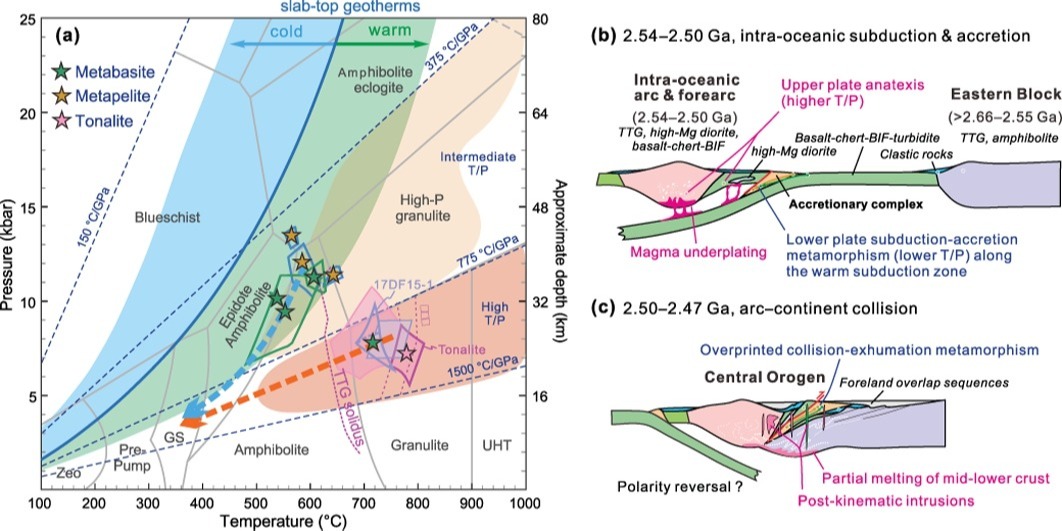Neoarchean Paired metamorphic belt in the southern North China Craton
Huang, B., Kusky, T.M.*, Johnson, T.E., Wilde, S.A., Wang, L., Polat, A. and Fu, D., 2020. Paired metamorphism in the Neoarchean: A record of accretionary-to-collisional orogenesis in the North China Craton. Earth and Planetary Science Letters, 543, 116355. https://doi.org/10.1016/j.epsl.2020.116355.
Highlights:
We document a spatially and temporally linked Neoarchean paired metamorphic belt.
Intermediate T/P metamorphism is consistent with thermal models of ‘warm’ subduction zones.
Our results support the operation of plate tectonics at the end of the Archean.
The tectonic regimes that operated in the Archean are hotly debated. Two major models have been proposed to explain the generation of Archean continental crust. Firstly, some form of subduction, perhaps related to a global plate tectonic regime, based on similarities with the ocean plate stratigraphy and geochemistry of modern accretionary complexes and/or oceanic lithosphere (e.g., Kusky et al., 2018; Polat et al., 2015). Alternatively, non-uniformitarian (pre-plate tectonic) modes that invoke melting near the base of oceanic plateaus, with or without plume tectonics, under a stagnant lid regime, including episodic crustal delamination and mantle overturns, based in part on the generalized dome-and-keel structure of some cratons and the predictions of geodynamic numerical modelling (e.g., Johnson et al., 2014; Sizova et al., 2015; Van Kranendonk et al., 2014). The debate is closely related to the timing of emergence and subsequent evolution of plate tectonics on Earth (e.g., Cawood et al., 2018; Korenaga, 2013; Stern, 2018; Turner et al., 2020; Webb et al., 2020). An important question is how to recognize reliable evidence in the rock record that might signify the operation of the plate tectonic regime.
The classic view of paired metamorphic belts refers to the orogen-parallel, contemporaneous in situ metamorphic belts characterized by inboard high thermal gradients (high T/P) and outboard low thermal gradients (low T/P) in Pacific-type accretionary orogens (Miyashiro, 1961), which are widely regarded as is the hallmark of asymmetric subduction at Phanerozoic convergent plate margins. Brown (2010) extended the concept of paired metamorphic belts to characterise tectonically juxtaposed metamorphic belts with higher (high T/P) and lower (low-to-medium T/P) thermal gradients in subduction-to-collision orogens, which appears more useful in gaining a better understanding of the relationship between thermal gradients and tectonic settings in ancient orogenic belts. Whereas many geochemical and geological features are controversial as indicators of geodynamic setting, the recognition of paired metamorphism in ancient rocks, reflecting a duality of thermal gradients associated with the subduction zone (low to intermediate T/P) and arc–backarc (high T/P) is widely regarded as a reliable indicator of subduction–collision (Brown, 2010; Brown et al., 2020; Holder et al., 2019; Miyashiro, 1961; Zheng and Zhao, 2020). However, few, if any, such spatially and temporally linked paired metamorphic belts have been well documented from Archean granite–greenstone terranes.
We investigate the Neoarchean Dengfeng Complex, a typical granite–greenstone belt in the southern part of the North China Craton (NCC). Using petrography, geochronology, and phase equilibrium constraints on rocks from different lithostructural units, we suggest the ca. 2.54–2.50-Ga Dengfeng Complex represents a remnant of a spatially and temporally linked Neoarchean paired metamorphic belt. In the western part of the complex, a garnet amphibolite from a dominantly metabasic unit (MBU) records near peak P–T conditions of 6.3–10 kbar and ∼675–750 °C, corresponding to a high thermobaric ratio (T/P) of ∼720–1200 °C/GPa. Tonalite–trondhjemite–granodiorite (TTG) gneisses preserve evidence for partial melting, also consistent with relatively high T/P (∼875–1400 °C/GPa). In the eastern part of the Dengfeng Complex, two garnet amphibolites and three garnet quartz–mica schists from a dominantly metasedimentary unit (MSU) record peak P–T conditions of >9.8 kbar and ∼525–655 °C, corresponding to intermediate thermobaric ratios of ∼425–600 °C/GPa. Zircon and titanite U–Pb dating, coupled with existing ages of post-kinematic intrusions, constrain the metamorphic age to ca. 2.52–2.50 Ga. The metamorphic P–T data indicate that the MSU was buried to >30 km then exhumed to the near-surface by the early Paleoproterozoic. Our metamorphic results, when combined with recent structural and geochemical data, suggest the Dengfeng Complex records Neoarchean paired metamorphism, in which the higher thermal gradients reflect the arc–forearc region and the lower thermal gradients correspond to the accretionary complex. Our data indicate that the southern NCC experienced accretionary-to-collisional orogenesis with intra-oceanic subduction, forearc accretion (ca. 2.54–2.50 Ga), and subsequent arc–continent collision (ca. 2.50–2.47 Ga).
The recognition of a remnant Neoarchean paired metamorphic belt in the Dengfeng Complex indicates subduction–collision processes were operating at the end of the Archean in the NCC, and potentially were widespread based on the paucity of preservation of paired metamorphic belts in the modern plate mosaic. Significantly, the medium T/P metamorphism recorded in the accretionary segment of the eastern Dengfeng Complex is broadly in line with ‘warm’ slab-top geotherms of the Neoproterozoic–Phanerozoic subduction zones around the world (Fig. 8a) (Penniston-Dorland et al., 2015), consistent with warmer geotherms associated with Neoarchean subduction zones, which might be related to the more common subduction of young (<30 Ma in this case) and warm oceanic slabs (e.g., van Keken et al., 2018), as well as higher mantle temperatures. The secular evolution in the patterns of paired metamorphism from intermediate–high T/P in the Neoarchean to widespread low/intermediate–high T/P in the Phanerozoic (minor in Paleoproterozoic) is likely a manifestation of secular cooling of the mantle and the associated styles of plate tectonics (e.g., Brown et al., 2020; Holder et al., 2019; Kusky, 2020; Zheng and Zhao, 2020).

Fig. 8. Summary of peak P–T conditions and the geodynamic model. Note that the peak metamorphic P–T conditions recorded in the metapelites and metabasites from the eastern part of the Dengfeng Complex are consistent with intermediate thermobaric ratios, whereas the metabasite and tonalitic gneiss in the west are consistent with high apparent geothermal gradients. The former is similar to slab-top geotherms of Neoproterozoic to Phanerozoic subduction zones (blue solid lines and shaded area) compiled by Penniston-Dorland et al., 2015.
 Huang-2020-EPSL.pdf
Huang-2020-EPSL.pdf